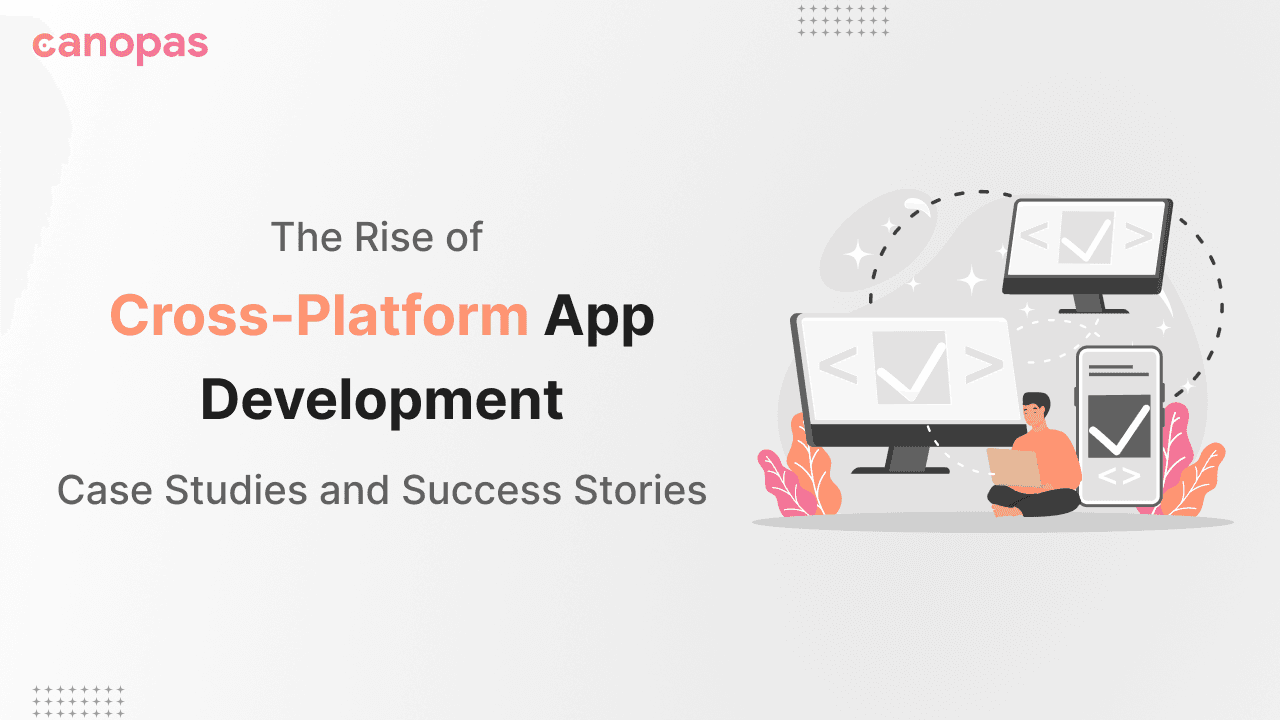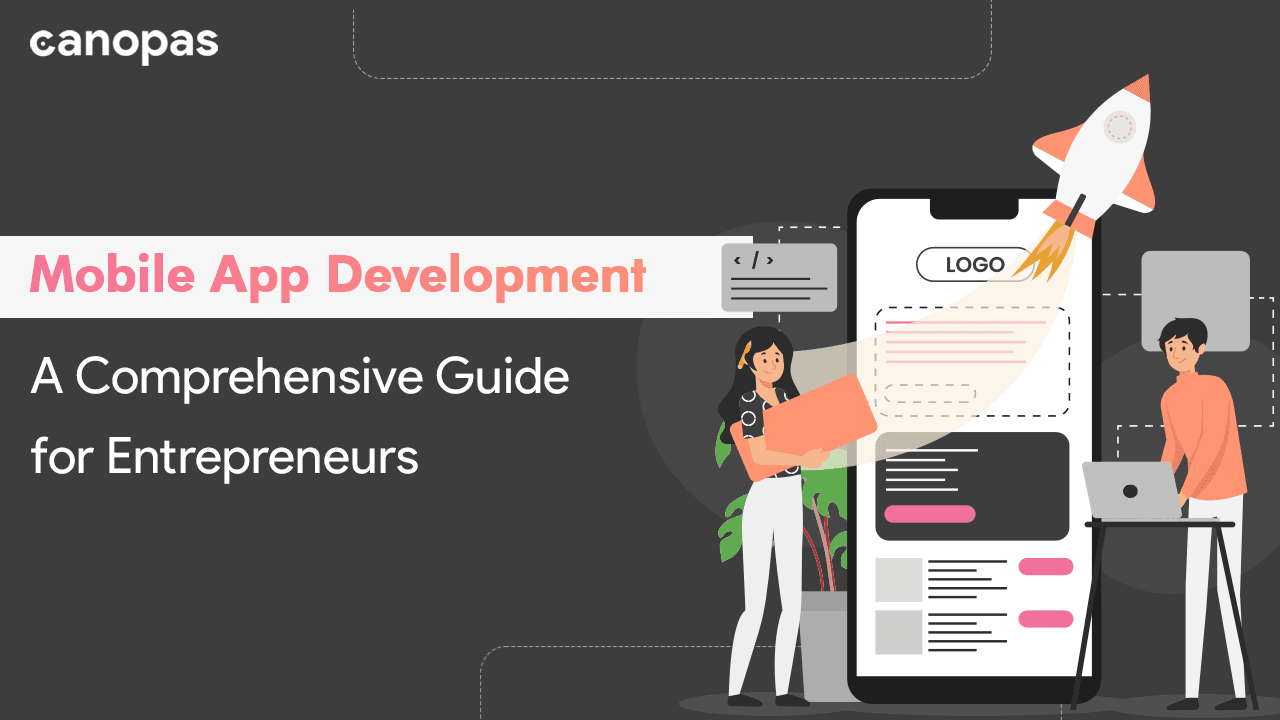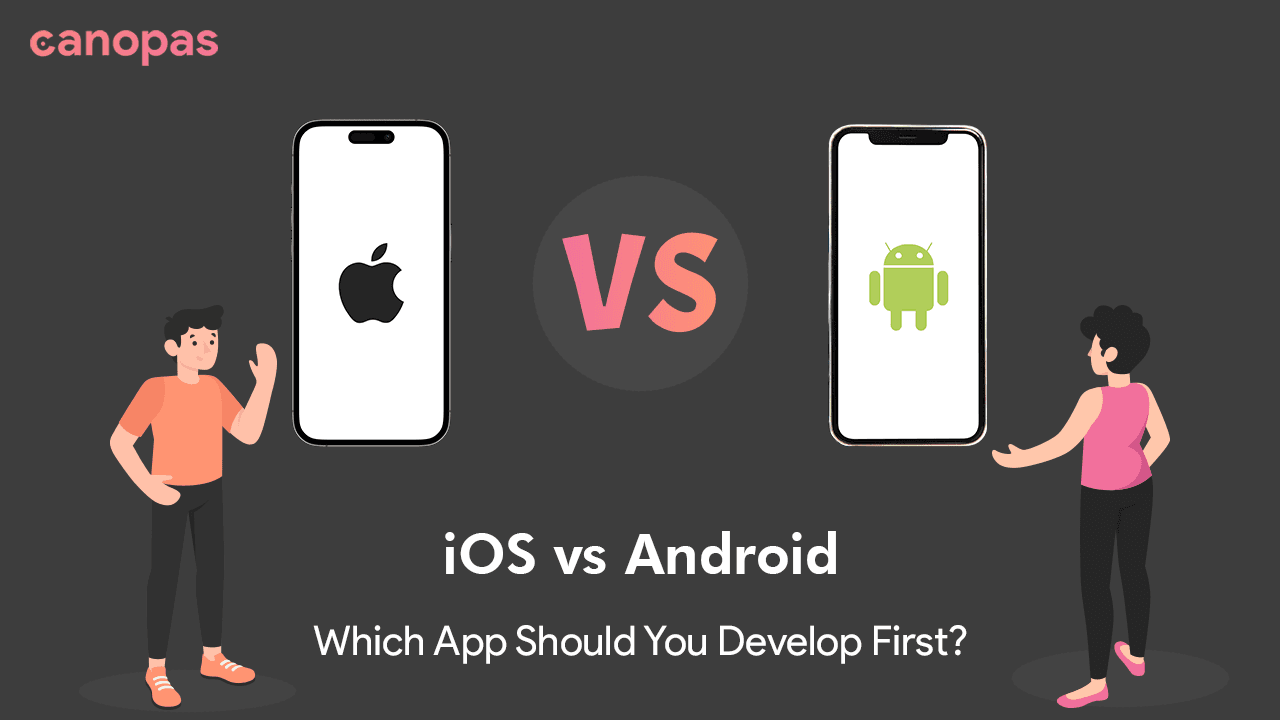
The Rise of Cross-Platform App Development — Case Studies and Success Stories
Introduction to Cross Platform Mobile App Development
Remember the days when mobile apps felt like exclusive members of either the Android or iOS club?
Those times are swiftly changing. Today, the lines are blurring, thanks to the magic of cross-platform development.
If this term feels like tech jargon, fret not. Think of it as a talented musician who can effortlessly play multiple instruments, making the entire orchestra come to life with just one set of hands.
Cross-platform development is the unsung hero behind many of your favorite apps, seamlessly functioning across your devices, regardless of their brand allegiance.
But why is it gaining traction? And more importantly, how are businesses leveraging it for maximum impact?
Join us as we unravel the journey of cross-platform development, showcasing inspiring case studies and success tales that demonstrate its transformative power in the mobile app universe.
Whether you're a tech enthusiast, a budding developer, or a business owner looking to scale up, this exploration promises to enlighten and inspire.
Let's dive in!
Historical Context
Earlier, mobile app development was akin to building two different houses from scratch – one for Android and one for iOS.
They each had their blueprints, bricks, and architectural designs. Building for one did not mean it could stand strong on the other's land. Here's a quick glance at how we evolved:
1. The Native Dynasty
In the early days, apps were native, meaning they were crafted specifically for a single platform. These apps took advantage of every nook and cranny of their home platforms, providing smooth experiences and tight integrations.
- iOS: Apps were designed using Objective-C or later, Swift, in the iOS ecosystem.
- Android: Java reigned supreme, with apps tailored for the vast and diverse world of Android devices.
The result?
High-performance apps with impeccable user experiences.
But there was a catch. Two platforms meant double the effort, time, and resources.
2. Early Cross-Platform Endeavors
As the app market grew, developers started seeking ways to streamline. Early cross-platform solutions, like PhoneGap and Titanium, entered the scene.
They promised a single codebase that could be "translated" into native code for both platforms.
However, these pioneers had their limitations.
While they did bridge the development divide to some extent, performance and access to native functionalities often took a hit.
Some apps felt like impersonators rather than genuine members of their platform's family.
3. The Shift in the Wind
With technology's unstoppable march, the teething problems of early cross-platform approaches paved the way for more sophisticated solutions.
Developers were no longer willing to compromise on performance for convenience, and tools started evolving to meet these expectations.
This historical backdrop sets the stage for our main attraction: the rise of modern cross-platform development.
As we venture forward, we'll witness the true heroes of today's app world and how they're revolutionizing the way we think about mobile software.
Why Cross-Platform Development is Rising
It's been a winding road, full of trial and error, from native apps to the more universal approach of cross-platform development.
But why has this latter method garnered such traction in recent years? Let's demystify the reasons behind its soaring popularity.
1. Economical Efficiency
At the heart of it, businesses love efficiencies, especially when it translates to cost savings.
Cross-platform development's promise of a singular codebase means that organizations can potentially halve their development efforts.
One team, one project timeline, and one set of tests often translate to substantial financial savings.
2. Speedier Market Entry
In the dynamic world of apps, timing can be everything. The ability to launch an app simultaneously on multiple platforms gives businesses a competitive edge.
They can capture a wider audience and avoid playing catch-up on one platform while they're already established on another.
3. Streamlined Maintenance and Updates
Post-launch, the journey is far from over. Apps require regular updates, bug fixes, and feature additions.
Managing these changes is considerably simpler when you're working with a shared codebase.
A single update can roll out across platforms, ensuring consistency in user experience and functionality.
4. Proliferation of Robust Tools
The technology behind cross-platform development has evolved leaps and bounds.
Frameworks like Flutter and React Native have risen, offering near-native performance and broader access to platform-specific features.
These tools have diminished the compromises developers had to make, making cross-platform a more attractive proposition.
5. Consistent User Experience
Brands strive for consistency. They want users to have a similar feel and experience, whether they’re using an app on an iPhone in New York or an Android device in Tokyo.
Cross-platform development facilitates this uniformity, reinforcing brand identity and ensuring that users don't feel out of place when switching devices.
6. Future-Proofing the Development
The tech world is notorious for its rapid shifts. New devices, platforms, and even entirely new tech ecosystems can emerge.
By investing in cross-platform, businesses position themselves in a more adaptable stance, ready to branch out to new platforms or devices with minimal friction.
In essence, the rise of cross-platform isn't just a fleeting trend. It's a calculated response to the evolving demands of businesses and users alike, seeking to reconcile quality, efficiency, and adaptability in the ever-expanding universe of mobile apps.
Case Study of Airbnb and React Native – A Journey of Exploration
Background of Airbnb
Airbnb, the global platform for community-driven hospitality services, is no stranger to innovation. As of 2016, they started integrating React Native into their development process.
Their goal was to speed up development time, maintain fewer codebases, and create a unified user experience across platforms.
The Challenge
- Massive User Base: With millions of users worldwide, Airbnb needed to ensure top-notch performance, consistent across all devices.
- Feature-rich App: The Airbnb app isn’t just about booking a stay. It has reviews, photos, maps, messaging, and more. Ensuring that all these features ran smoothly on cross-platform was a challenge.
- Developer Productivity: With an already established app, Airbnb aimed to streamline its development process, allowing developers to ship features faster without compromising on quality.
The Cross-Platform Solution
React Native was Airbnb's tool of choice. With it, they started building reusable components.
By 2018, numerous features in Airbnb’s app were developed using React Native, resulting in hundreds of screens across guest and host workflows.
Outcomes and Results
- Rapid Development: Using React Native, Airbnb noted that it enabled a significant increase in the speed of development. Features could be rolled out faster than before.
- Unified User Experience: By using a shared component base, the Airbnb app maintained a consistent look and feel across iOS and Android.
- Shared Knowledge Base: Developers at Airbnb appreciated the flexibility React Native provided. They could write and understand code across platforms, fostering a shared knowledge base.
However, it's essential to note that by mid-2018, Airbnb decided to wind down their use of React Native.
This decision wasn't a failure of cross-platform development but rather specific to Airbnb's unique challenges and the evolution of their product.
Key Takeaways
Airbnb’s experiment with React Native reveals both the potential and the complexities of cross-platform development.
Their journey underscores the importance of businesses assessing their long-term needs and understanding that while tools like React Native can offer immense advantages, there might be situations where going native becomes a strategic decision.
Case Study: Pinterest – Crafting Inspiration with Cross-Platform Development
Background of Pinterest
Pinterest, the popular visual discovery engine, allows users to find inspiration and ideas for various projects and interests, from home and style to food and travel.
With a vast majority of its user base on mobile, delivering a consistent and high-quality app experience was paramount.
The Challenge
- Visual Appeal: As a platform built around visuals, the app needed to be highly performative, ensuring images and videos load quickly and display beautifully across devices.
- Engaging User Experience: With features like boards, pins, and personalized feed, ensuring smooth interactions was crucial.
- Rapid Iteration: Pinterest constantly evolves, with new features and improvements being a regular occurrence. This required a nimble development approach.
The Cross-Platform Solution
Pinterest chose to adopt React Native for parts of its app to bridge the development for iOS and Android.
This allowed them to share a good portion of the codebase between platforms while still optimizing native modules where necessary.
Outcomes and Results
- Unified Branding: By using React Native, Pinterest was able to maintain consistent branding and UI/UX elements across both Android and iOS platforms.
- Faster Time-to-Market: The cross-platform development approach enabled Pinterest to speed up the rollout of new features and enhancements.
- Shared Learning: Bugs, performance issues, and user feedback could be addressed in a unified manner, reducing duplicated efforts and fostering a cohesive development approach.
Key Takeaways
Pinterest's foray into cross-platform development underscores the value of a hybrid approach.
By choosing React Native for certain app modules and native development for others, they struck a balance that maximized efficiency without compromising on user experience.
Challenges and Considerations in Cross-Platform Development
While cross-platform development offers numerous advantages, as with any technology, it comes with its set of challenges.
Recognizing these hurdles ensures that businesses can make informed decisions and plan strategically.
Here are some considerations to keep in mind.
1. Performance Differences
While cross-platform tools have come a long way, there can still be subtle performance differences when compared to native apps, especially in graphics-intensive applications or those requiring specific hardware features. But they're improving day by day and we're not far away from the time when most startups(if not all) will use it for their MVP or Idea Validation.
2. Native Features Access
While frameworks like React Native and Flutter provide access to many native functionalities, there might be specific platform-specific features that they can't tap into directly, requiring additional native modules.
3. UI and UX Disparities
Although cross-platform tools aim for a consistent look and feel, the design paradigms of iOS and Android are inherently different. Achieving a seamless design might require extra effort and fine-tuning.
4. Framework Limitations
All frameworks have limitations. As businesses grow and evolve, they might outgrow the capacities of their chosen framework, necessitating pivots or supplementary solutions.
5. Maintenance Overhead
While initial development might be streamlined, maintaining a cross-platform app isn't without challenges.
Framework updates, platform updates, or changes in platform guidelines can introduce unforeseen issues.
6. Team Skill Set
Adopting cross-platform development might necessitate a change in the skill set of the development team. Transitioning or training might be required, which can impact project timelines.
7. Long-Term Viability
The tech landscape is ever-evolving. The chosen cross-platform tool should have a robust community, consistent updates, and long-term viability to ensure the business doesn't face disruption due to deprecated tools or unsupported technologies.
Cross-platform development, while powerful, isn't a one-size-fits-all solution. The key lies in understanding its strengths and limitations.
By aligning business goals with the capabilities of cross-platform tools, companies can harness its benefits while being prepared for potential roadblocks.
Future of Cross-Platform Development — What Lies Ahead?
The technological world is an ever-evolving landscape, with new advancements and shifts redefining possibilities.
In the realm of app development, cross-platform frameworks have garnered significant attention and adoption. But where are we headed next?
Here are some ways cross platform frameworks might evolve in the future.
1. Increased Adoption and Reliance
The evident benefits - cost savings, reduced time-to-market, and consistency across platforms - have already made many companies opt for cross-platform development.
With further advancements in frameworks like React Native and Flutter, we can expect even more businesses, from startups to enterprises, to lean on these technologies.
2. Enhanced Performance Capabilities
One of the critiques of cross-platform development has been potential performance disparities compared to native solutions. However, with the evolution of frameworks and tools, these gaps are closing.
Soon, it might be hard to distinguish between a well-developed cross-platform app and a native one in terms of performance.
3. More Native Features Integration
Cross-platform frameworks are continuously working to bridge the divide between them and native functionalities.
Expect more native modules and plugins to emerge, making it easier to access device-specific features without leaving the cross-platform environment.
4. Machine Learning and AR Integration
With Machine Learning and Augmented Reality becoming significant trends in app development, cross-platform tools will evolve to seamlessly integrate these technologies.
This will allow developers to create sophisticated, futuristic apps irrespective of the platform.
5. Cloud Integration and Real-time Synchronization
The future is all about interconnectedness. Cross-platform apps will become more integrated with cloud solutions, allowing real-time synchronization and data accessibility across devices.
This means a user could switch from using an app on their smartphone to their tablet without missing a beat.
6. Emphasis on Security
As the adoption grows, so will the emphasis on security. Frameworks will introduce more robust security protocols, ensuring that cross-platform apps are just as secure as their native counterparts, if not more.
The trajectory for cross-platform development is promising.
As technology continues to evolve, the lines between native and cross-platform apps will blur, paving the way for a more unified, efficient, and innovative app development ecosystem.
Making the Choice — When to Opt for Cross-Platform Development
Deciding between native and cross-platform development can be a daunting task for businesses.
While we've explored the advantages of cross-platform development and witnessed its successes, it's crucial to understand when it's the optimal choice.
Here are scenarios where cross-platform development might be the right decision.
1. Limited Budget and Resources
If you're a startup or a small business with a constrained budget, cross-platform development offers the advantage of reaching multiple platforms with a single development effort, saving both time and money.
2. MVPs and Prototyping
For businesses looking to test a new app idea, cross-platform frameworks allow for quicker Minimum Viable Product (MVP) development. You can gauge market response and iterate without heavy investment.
3. Consistent UI/UX Across Platforms
If your primary goal is to ensure a uniform appearance and feel of your app on all devices, then cross-platform development can offer that consistency, given the shared codebase.
4. Non-intensive Graphics Apps
While cross-platform development has come a long way, extremely graphics-intensive apps (like high-end games) might still benefit more from native development.
But for apps that don’t rely heavily on intricate graphics, cross-platform can be an excellent choice.
5. Need for Faster Market Launch
When you want to capitalize on a market trend or have a timely app idea, the quicker development cycle of cross-platform apps can be a boon, enabling you to launch on both iOS and Android simultaneously.
6. Maintenance and Updates
For businesses that foresee frequent updates – be it feature additions, bug fixes, or seasonal changes – managing a single codebase can be far simpler and more efficient than juggling separate ones for iOS and Android.
Factors to Consider:
- Performance Needs: Analyze if your app needs extremely high performance or if it uses device-specific features intensively. In such cases, you might need to evaluate the capabilities of cross-platform frameworks carefully or even consider a hybrid approach.
- Long-term Strategy: Think about your long-term goals. If you see your app evolving into a more complex platform, factor in how cross-platform development will fit into this evolution.
- User Base: Understand where your primary user base lies. If a significant chunk is concentrated on a single platform (iOS or Android), then initial native development might make sense. But if you’re aiming for global reach, cross-platform can be invaluable.
Cross-platform development isn't a one-size-fits-all solution, but it offers undeniable benefits in the right scenarios.
By aligning your business needs, user expectations, and development capabilities, you can make an informed decision that propels your app to success.
Conclusion — The Cross-Platform Confluence
The digital age is marked by rapid change, innovation, and the incessant pursuit of efficiency.
In the mobile app development arena, the ascent of cross-platform methodologies exemplifies this trend, promising faster go-to-market strategies, cost savings, and a cohesive user experience across diverse device ecosystems.
Through the lens of successful brands like Pinterest and Airbnb, we've witnessed the tangible benefits and expansive potential of cross-platform development.
While it isn't devoid of challenges, the dynamic landscape of this domain is continuously evolving, bridging performance gaps, and introducing features that inch closer to native experiences every day.
The pivotal question isn't about the validity of cross-platform development; it's about its alignment with your business goals, user base, and the unique challenges you aim to solve.
It's about discerning when to embrace this approach and how to maximize its strengths while navigating its limitations.
As the horizons of technology continue to expand, one thing remains certain: cross-platform development will be an integral part of this journey.
For businesses and developers poised at the crossroads, the path illuminated by cross-platform's promise is one of opportunity, innovation, and a future crafted with agility.
Ready to harness the power of cross-platform development for your business?
Let our expert team guide you. Contact us today to embark on a journey tailored to your app aspirations and market objectives.






Let's Work Together
Not sure where to start? We also offer code and architecture reviews, strategic planning, and more.


